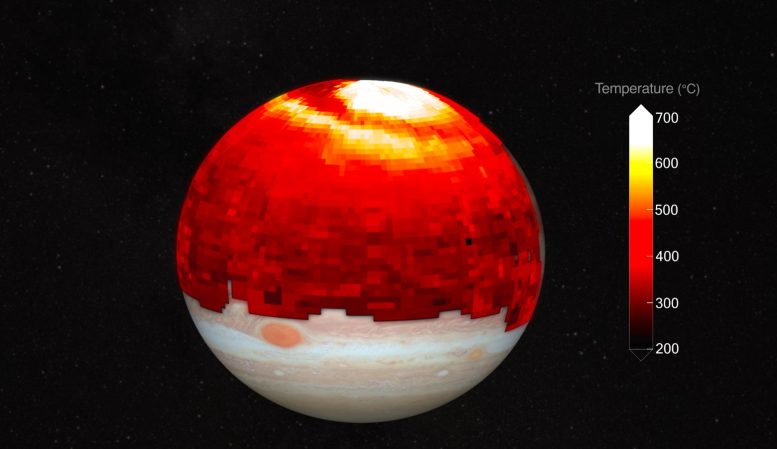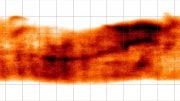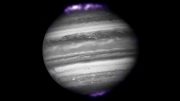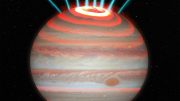
A panning-view of Jupiter’s upper atmospheric temperatures, 1000 kilometers above the cloud tops. Jupiter is shown on top of a visible image for context. In this snapshot, the auroral region (near the northern pole, in yellow/white) appears to have shed a massive, planetary-scale wave of heating towards the equator. The feature is over 130,000 kilometers long, or 10-Earth diameters, and is hundreds of degrees warmer than the background. Credit: Hubble / NASA / ESA / A. Simon (NASA GSFC) / J. Schmidt, James O’Donoghue
An unexpected ‘heat wave’ has been discovered in Jupiter’s atmosphere. It reaches a scorching temperature of 700 degrees Celsius (1300 degrees Fahrenheit) and extends 130,000 kilometers (10 Earth diameters). James O’Donoghue, of the Japanese Aerospace Exploration Agency (JAXA), presented the results at the Europlanet Science Congress (EPSC) 2022 in Granada.
Jupiter’s atmosphere is famous for its characteristic multicolored vortices. However, it is also unexpectedly hot. In fact, it is hundreds of degrees hotter than models predict. After all, the giant planet receives under 4% of the amount of sunlight compared to Earth, due to its orbital distance of 483 million miles (778 million km) from the Sun. Therefore its upper atmosphere should theoretically be a frigid -70 degrees Celsius (-100 degrees Fahrenheit). Instead, its cloud tops are measured everywhere at over 400 degrees Celsius (750 degrees Fahrenheit).
“Last year we produced – and presented at EPSC2021 – the first maps of Jupiter’s upper atmosphere capable of identifying the dominant heat sources,” said Dr. O’Donoghue. “Thanks to these maps, we demonstrated that Jupiter’s auroras were a possible mechanism that could explain these temperatures.”
Just like the Earth, Jupiter experiences auroras around its poles as an effect of the solar wind. However, auroras at Jupiter are permanent and have a variable intensity, while Earth’s auroras are transient and only occur when solar activity is intense. The powerful auroras can heat the region around the poles to over 700 degrees Celsius, and global winds can redistribute the heat globally around Jupiter.
Looking more deeply through their data, Dr. O’Donoghue and his research team discovered the spectacular ‘heat wave’ just below the northern aurora, and found that it was traveling towards the equator at a speed of thousands of kilometers per hour.
The heat wave was most likely triggered by a pulse of enhanced solar wind plasma impacting Jupiter’s magnetic field. This would have boosted auroral heating and forced hot gases to expand and spill out towards the equator.
“While the auroras continuously deliver heat to the rest of the planet, these heat wave ‘events’ represent an additional, significant energy source,” added Dr. O’Donoghue. “These findings add to our knowledge of Jupiter’s upper-atmospheric weather and climate, and are a great help in trying to solve the ‘energy crisis’ problem that plagues research into the giant planets.”
Meeting: Europlanet Science Congress (EPSC) 2022









The heat wave was most likely triggered by a pulse of enhanced solar wind plasma impacting Jupiter’s magnetic field. This would have boosted auroral heating and forced hot gases to expand and spill out towards the equator.Why such a mechanism not a factor
to be considered to explain earth climate change?
It is the lower troposphere that appears to be warming on Earth. However, Earth has a thermosphere that appears analogous to what is observed on Jupiter.
https://spaceplace.nasa.gov/thermosphere/en/
Stop using fossil fuels on earth to stop Jupiter’s warming.
I suppose it’s called “Global warming” or “climate change” yes?